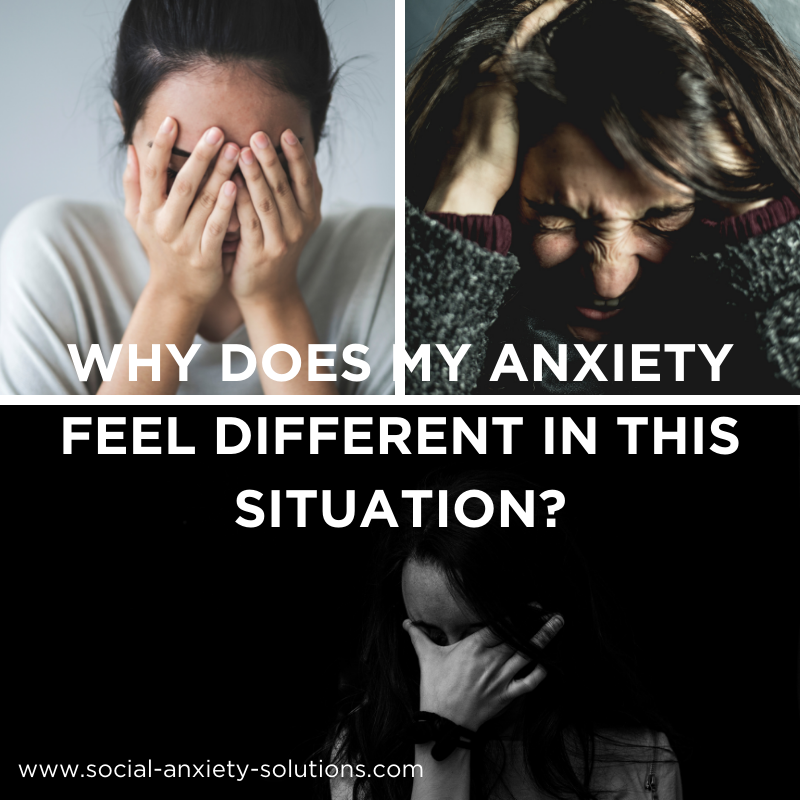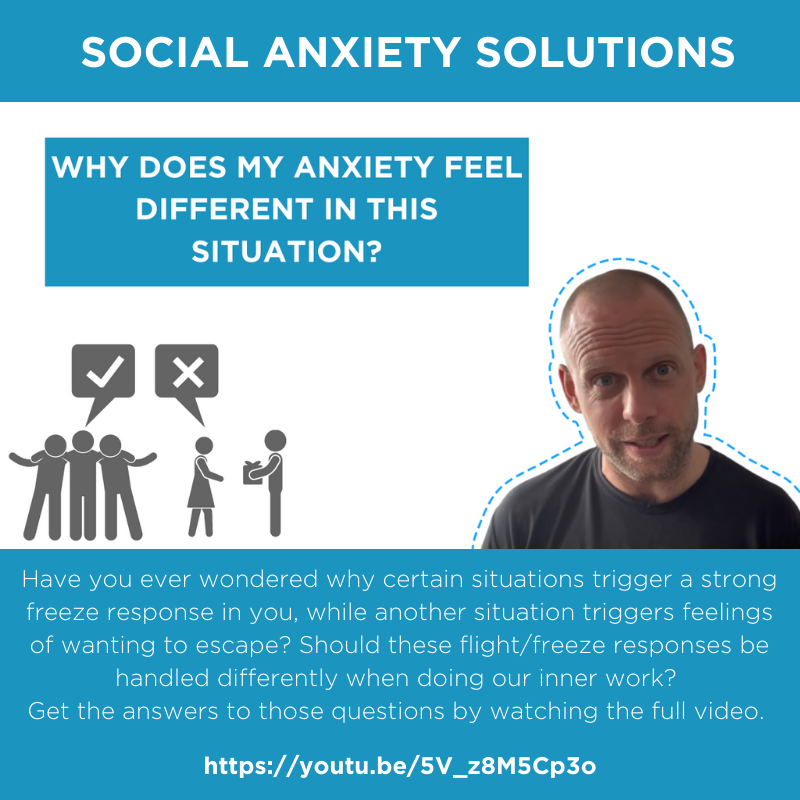SUMMARY
Why does my anxiety feel different in this situation?
Have you ever wondered why certain situations trigger a strong freeze response in you, while another situation triggers feelings of wanting to escape?
Should these flight/freeze responses be handled differently when doing our inner work?
Get the answers to those questions by watching the full video.
Learn how you can overcome your social anxiety through a scientifically proven technique called EFT tapping.
Simply go to www.social-anxiety-solutions.com
Get your FREE Social Confidence Starter Kit and start chipping away your social anxiety today!
FULL TRANSCRIPTION
My anxiety in this situation feels different in that situation…why is that?
Hey, my name is Sebastiaan from social-anxiety-solutions.com
I’m a former Social Anxiety Disorder sufferer and a Social Confidence Coach.
I’ve got 12 years of experience coaching people with social anxiety to feel calm, relaxed, and at ease in social situations.
And today, I’m answering your particular question that was made by our good friend, Graham. And he writes:
Hi Lia 🙂
I have a question for Seb.
I’ve noticed that different triggers cause a different physiological change in me.
Some situations will trigger a strong freeze response where I feel myself rooted to the spot and my core feels tight and frozen.
Other triggers will result in more of a flight energy where I just want to escape the situation and feel very activated.
My question is, what are some differences when working with these flight/freeze energies? Do they typically release in a similar way?
Thanks Seb,
Graham
**
Hi Graham! Excellent question.
In general? I work with them the same.
But let’s talk a little bit about the differences in what they are.
The fight-flight-freeze response is what happens when your brain perceives danger. Like there’s a real threat to your survival. And at that moment, your brain, if it cannot fight the danger because you’re not strong enough or it’s not fightable. Or if it can’t outrun the danger, or it’s not, you know, you can run from it, then it only has one other option. Though some experts say that there are two other options, there’s also the FAWN response. You might want to look into that if you find it interesting, but I won’t go into it.
So there’s the freeze response. So if you can’t fight, you freeze, and you play dead. So that response is stuck in the body. And in animals, they automatically discharge that freeze response.
[Example] Gazelle is out in the woods; the tiger comes along. Well, guess what? You can’t really fight the tiger because it’s going to lose. So what does it do? It bolts! It runs, it takes off, and it tries to escape.Now at the moment, just before the tiger is about the bite the gazelle, the gazelle gives up and freezes. Its system automatically freezes, numbs the feelings, and gazelle gets bitten, and the tiger drags the gazelle behind the bushes.
Now, in case, miraculously, this Gazelle survives it because the lion or the tiger gets distracted. And the gazelle runs off and escapes (and they videotape this). Later on, the Gazelle comes back to his tribe of other gazelles and then starts involuntarily shaking. It discharges the freeze response.
If you find that interesting, google it—lots of information from trauma experts on this topic.
And we, as humans, don’t discharge the freeze response, for whatever reason, and there are reasons for it that I won’t go into.
And so, a way to discharge the freeze response is to work with tapping. You can work with the feelings in the body. You can go back to where the original experience was and release the feelings of that younger you.
There’s also something called TRE, developed by psychologist David Berceli, which stands for Trauma Release Exercises, which are various exercises that instigate the discharge of the freeze response that’s gotten stuck in the body.
And it involves a bunch of exercises where you tire out the leg muscles and your groin. You’re activating your psoas muscle where a lot of this freeze response is being held. And eventually, and I’ve done it many times, you’ll end up lying on the floor, in kind of like a butterfly position with your knees (Pointing at the elbows – Imagine that these are your knees), and you start involuntary shaking.
And in a while, it goes through your whole body.
And you’re not doing it – it’s happening automatically. And after you’re done with that shaking. You do it for a certain amount of time. I can’t give you instructions because it’s not my technique. Look up David Berceli (TRE). You discharge some of that freeze response, and you feel more calm; you feel more centered in your body.
So that’s in particular for discharging, fight-flight-freeze response. So that’s another technique I can top of the mind think of. But in other ways, lots of clients have lots of freeze responses that are stuck in the body. And we simply work with them in the same way that we do.
Another thing that comes to mind, as we’re talking about this topic is, there are different kinds of experiences that I’ve had from anxiety, just like you say, there’s the freeze and frozen, or like, have a high intensity, real fearful anxiety response.
And there’s the “I feel locked up. I can’t really express myself, and I feel tense and rigid and so on”.
The first is more of a fear response. And you want to look at the fears that you have.
The second is usually more of a response that has to do with your rules about how you should be, and how you shouldn’t be, what you have to be and what you can’t be.
And you’re very rigid in your ways of being, and you might violate these rules that you have about how you should socialize, what you can do, how you can feel, how you cannot feel, and so on.
You want to loosen that up.
So there are varieties in the experience that you can have with anxiety, and we address them pretty much the same way.
What’s going on for you?
What’s the elephant in the room?
And just follow the trail that your subconscious brings to mind.
Aim it at the thought.
Aim at the feeling in the body.
Aim it at the emotion that you’re experiencing.
Aim it at the memory.
Aim it at the image.
Aim it at the future projection.
And just keep tapping, just keep tapping, bit by bit, chipping away at all the layers of social anxiety, you’re going to get to where you want to be.
So thank you, great questions. This is Sebastiaan from social-anxiety-solutions.com
If you want to learn more about how to use tapping to overcome your social anxiety, go to social-anxiety-solutions.com click on Overcome Social Anxiety, you get a free social competence starter kit, a little mini-course to start reducing your social anxiety right away.
All right, this lesson from social-anxiety-solutions.com signing off.
Bye for now.
Bye!
If you experience Social Anxiety, click below to receive the FREE “7 Secrets to Social Confidence” Mini Course!
- How To Stop Worrying - January 17, 2024
- How to Reduce Facial Blushing with EFT Tapping? - June 29, 2023
- Are You Scared to Get Anxious? Here’s how to fix it! - June 16, 2023





